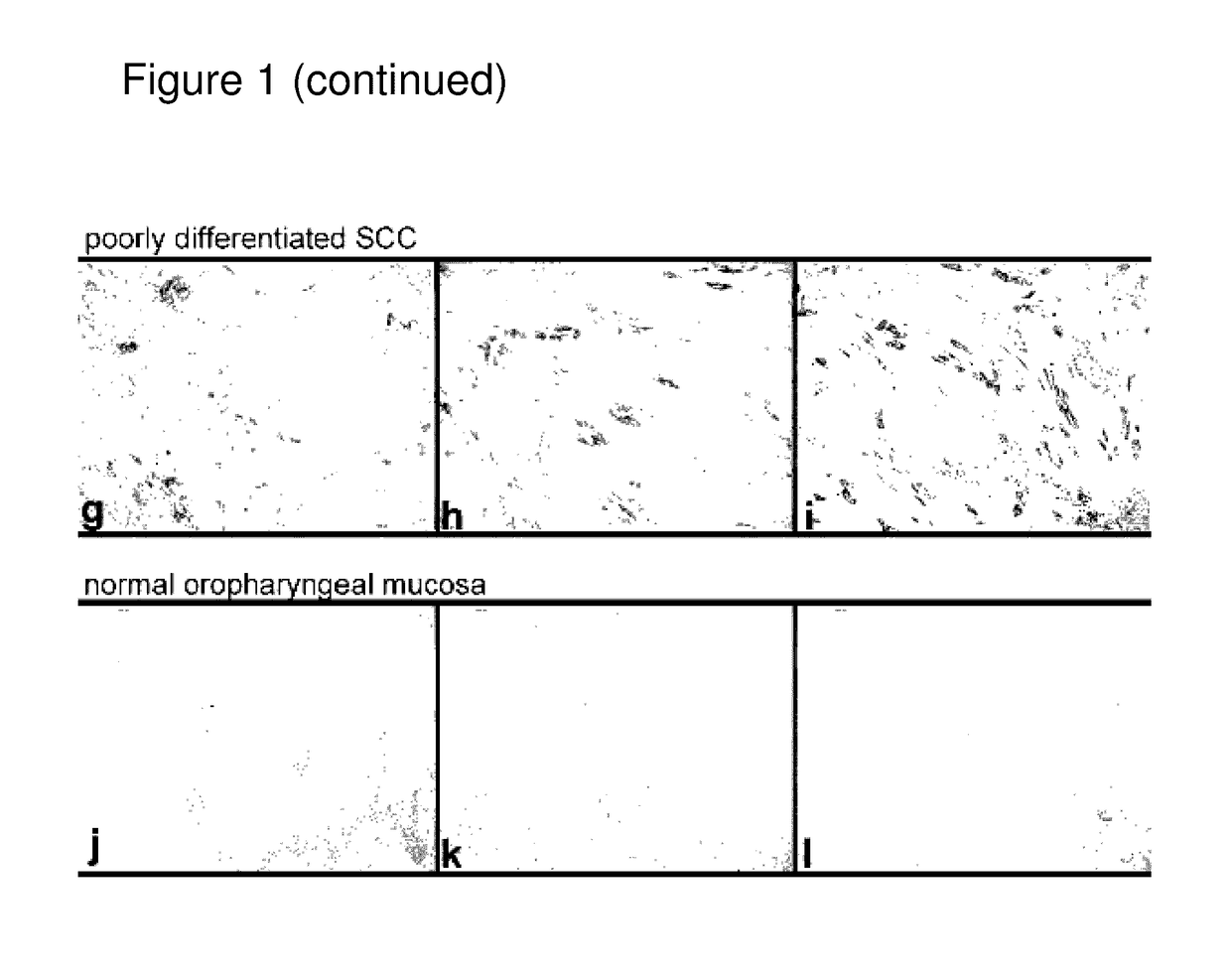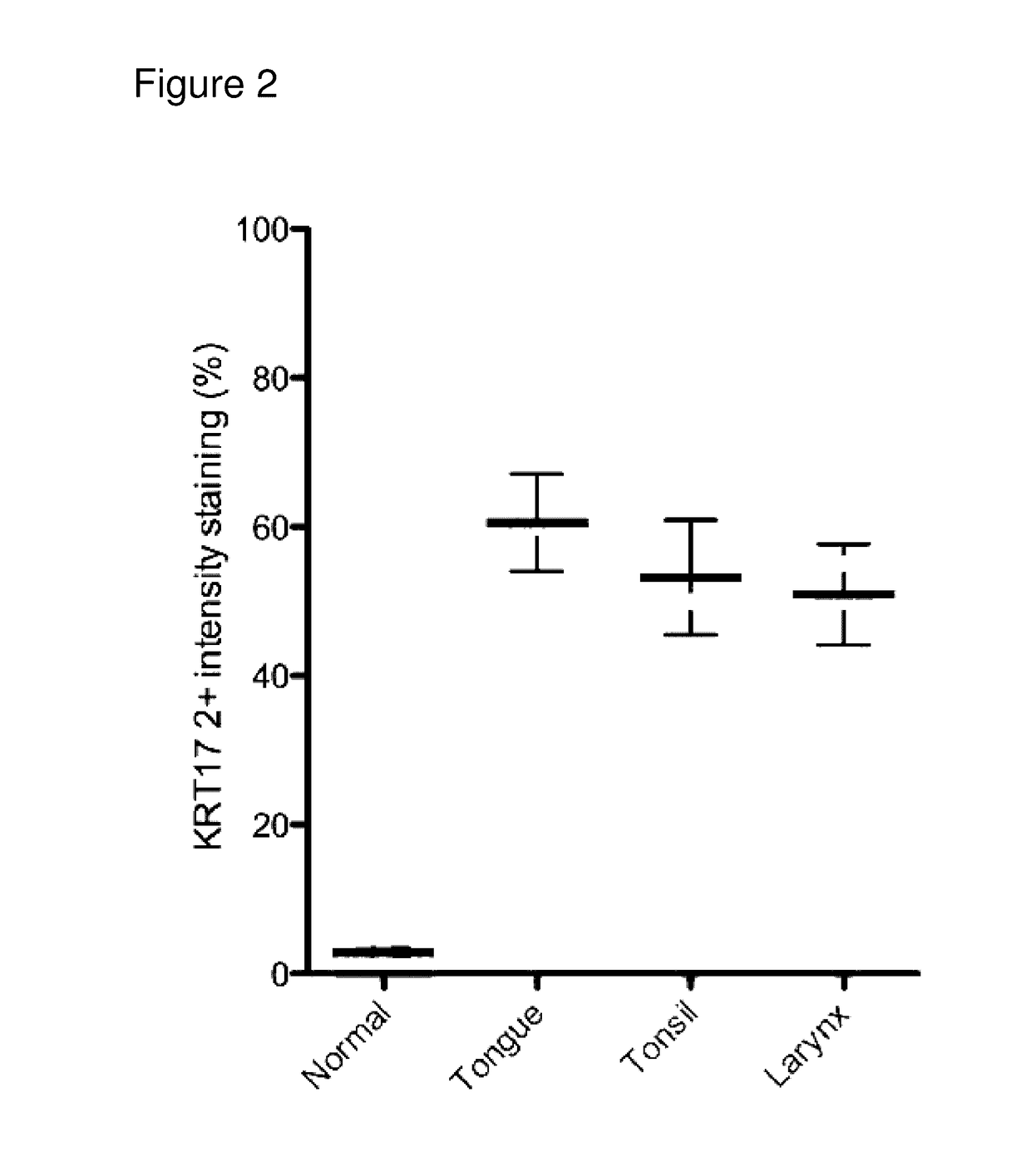Keratin 17 as a biomarker for head and neck cancers
a biomarker and keratin technology, applied in the field of keratin 17 as a biomarker for head and neck cancer, can solve the problems of no prognostic biomarkers available, no analysis of krt17's role in the development and progression of hnscc, and poor prognosis of patients with hnscc, etc., to achieve short survival time, reduce the incidence of survival, and increase the krt17
- Summary
- Abstract
- Description
- Claims
- Application Information
AI Technical Summary
Benefits of technology
Problems solved by technology
Method used
Image
Examples
example 1
Materials and Methods
[0066]Case Selection.
[0067]A total of 25 laryngeal SCCs, 29 lingual SCCs, and 24 tonsillar SCCs were selected from the archival Pathology collections of the Biobank at Stony Brook University Medical Center. Ten laryngeal, 9 lingual, and 15 tonsillar non-cancerous tissue specimens (i.e., control samples) were also selected from the archival pathology collections. Additionally, nodal metastases representative of all three anatomic regions were concurrently selected (n=6). Representative sections from each case were selected by a pathologist and grading was performed on a three-point scale (Grade 1-3).
[0068]Immunohistochemical Staining.
[0069]Immunohistochemical staining was performed on paraffin-embedded tissue samples obtained from subjects. Specifically, formalin-fixed, paraffin-embedded tissue sections obtained from subjects were marked on glass slides. After incubation at 60° C. for 1 h, tissue microarray slides were deparaffinized in xylene and rehydrated usin...
example 2
Cytokeratin 17 is Overexpressed in Lingual, Tonsillar, and Laryngeal SCCs
[0079]Cytoplasmic staining for KRT17 was detected in 78 of 78 (100%) HNSCC tissues specimens (FIG. 1a-i). The proportion of cells with strong (2+) staining ranged from 0 to 100% in the HNSCCs, with a mean 2+KRT17 expression of 60.6±6.6% in lingual, 53.2±7.7% in tonsillar, and 50.9±6.8% in laryngeal carcinomas (FIG. 2). When tumors were grouped by grade, KRT17 expression was reduced in poorly differentiated SCCs (51.5%±8.0%) and moderately differentiated SCCs (51.6%±5.3%) when compared to in well-differentiated SCCs (74.6%±6.9%) (FIG. 3a). When tumors were grouped by stage, KRT17 expression was significantly increased in all stages of HNSCC when compared to normal squamous mucosa (i.e., control samples).
[0080]Within the SCCs, several patterns of KRT17 distribution were observed. For example, certain samples exhibited staining primarily at the periphery of invasive nests of tumor cells (FIG. 4a). Other samples sh...
example 3
Cytokeratin 17 Expression is Consistent Between the Primary Tumor and Nodal Metastases
[0081]KRT17 expression in six representative cases was compared between the primary tumor and the concurrently diagnosed lymph node metastases. In five of the six cases, the intensity of staining between primary and metastatic tumor sites was consistent (FIG. 6a, b), i.e., primary tumors with high (2+) KRT17 staining had nodal metastases with high (2+) KRT17 staining.
PUM
| Property | Measurement | Unit |
|---|---|---|
| pH | aaaaa | aaaaa |
| prognostic threshold | aaaaa | aaaaa |
| microscopy | aaaaa | aaaaa |
Abstract
Description
Claims
Application Information
 Login to View More
Login to View More - R&D
- Intellectual Property
- Life Sciences
- Materials
- Tech Scout
- Unparalleled Data Quality
- Higher Quality Content
- 60% Fewer Hallucinations
Browse by: Latest US Patents, China's latest patents, Technical Efficacy Thesaurus, Application Domain, Technology Topic, Popular Technical Reports.
© 2025 PatSnap. All rights reserved.Legal|Privacy policy|Modern Slavery Act Transparency Statement|Sitemap|About US| Contact US: help@patsnap.com



